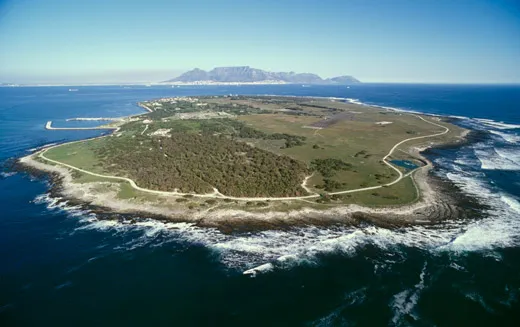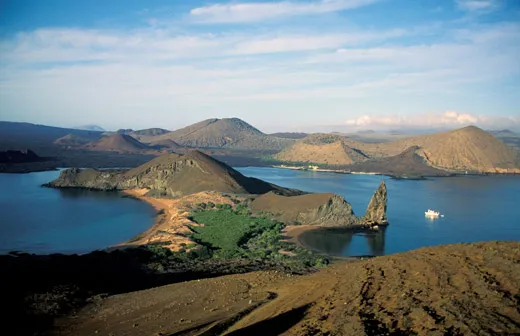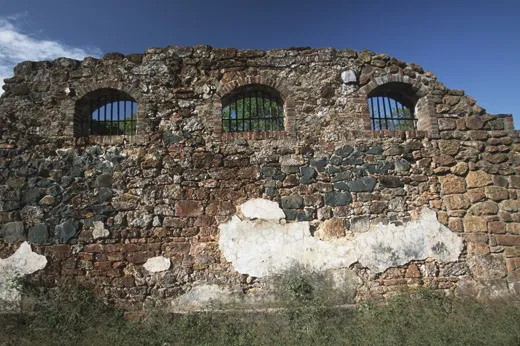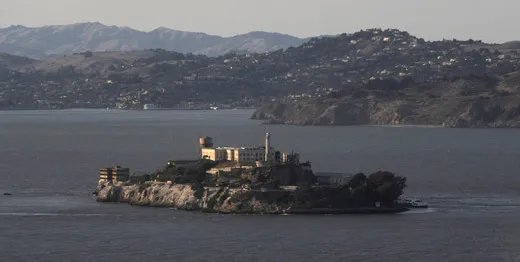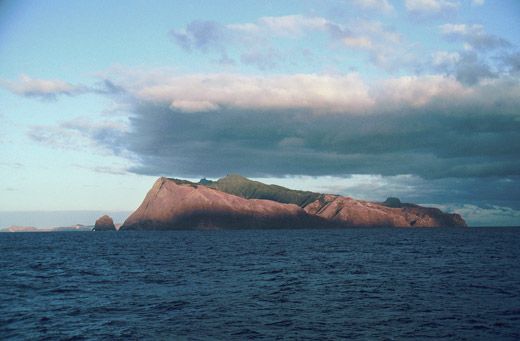Ten Infamous Islands of Exile
Established to banish dissidents and criminals, these islands are known for their one-time prisoners, from Napoleon to Nelson Mandela
/https://tf-cmsv2-smithsonianmag-media.s3.amazonaws.com/filer/Islands-Robinson-Crusoe-Island-Chile-631.jpg)
Patmos, Greece
A tiny, mountainous speck in the Aegean Sea, the 13-square-mile island of Patmos is where, according to Christian tradition, St. John was exiled in A.D. 95 after being persecuted for his faith by the Romans and where he wrote his Gospel and the Book of Revelation. Ten centuries later, in 1088, a monk built a monastery on the island dedicated to the saint. This established Patmos as a pilgrimage site and a center of Greek Orthodox learning, which it remains to this day. In 1999, Unesco declared the Monastery of Saint John the Theologian—along with the Cave of the Apocalypse, where St. John is said to have received his revelations from God, and the nearby medieval settlement of Chora—a World Heritage site. Unesco stated: “There are few other places in the world where religious ceremonies that date back to the early Christian times are still being practiced unchanged.”
Sado Island, Japan
With its dramatic mountains, lush forests and temperate climate, Sado Island is now a popular retreat. But in medieval times, the island, 32 miles west of Niigata Prefecture in the Sea of Japan, was a place of banishment for those who had fallen out of favor with the rulers of the day. More than 70 people—notably aristocrats and artists—were exiled here, beginning in A.D. 722 with the poet Asomioyu Hozumi, who criticized the emperor. Other exiles included the Emperor Juntoku, who attempted a coup against the Kamakura shogunate in 1220, and the monk Nichiren in 1271, who preached a radical form of Buddhism. Today, many attribute the island’s eclectic population and cultural riches—Sado has more than 30 Noh stages and is known as the “Island of Performing Arts”—to the presence of these early exiles.
Île Sainte-Marguerite, France
Just off the coast of Cannes in the Mediterranean Sea, the small, forested island of Sainte-Marguerite—about two miles long and a half-mile wide—was home to one of history’s most enigmatic prisoners. The convict, whose identity was concealed behind what was most likely a black velvet mask, was brought to the island in 1687, during the reign of Louis XIV, and locked up in the Royal Fort, then a state prison. (His barren cell can still be seen.) Later, he was moved to the Bastille, where he died in 1703 at around age 45.
The prisoner’s identity and the reason for his incarceration are still not known. But over the centuries, they have been the subjects of much speculation. One popular theory, that he was an older brother of Louis XIV, became the basis for Alexander Dumas’ classic tale The Man in the Iron Mask.
The Royal Fort continued to be used as a prison until the 20th century. Today it houses the Musée de la Mer, devoted to marine archaeology.
Robinson Crusoe Island, Chile
In 1704, British privateer Alexander Selkirk was marooned on Isla Más a Tierra in the Pacific after quarreling with the captain of his ship, the Cinque Ports. He lived alone on the rugged 29-square-mile island, 418 miles off Valparaiso, Chile, for more than four years, subsisting on fish, lobster, goats and seals, until he was rescued by a passing ship in February 1709. Woodes Rogers, the captain, described Selkirk upon rescue as “a man Cloth’d in Goat-Skins, who look’d wilder than the first Owners of them.” Selkirk’s ordeal is believed to have been the inspiration for Daniel Defoe’s novel Robinson Crusoe, published in 1719.
The Chilean government renamed Isla Más a Tierra to Robinson Crusoe Island in 1966, in hopes of attracting tourism.
Devil’s Island, French Guiana
History’s most notorious penal colony, Devil’s Island actually consisted of several prisons, one on the mainland near the capital, Cayenne, and three offshore, reserved for the most dangerous offenders: Isle Royale, Isle St. Joseph and tiny Devil’s Island. Napoleon III established the penal colony in 1854, and some 80,000 French convicts—criminals, spies and political prisoners—would be sent there before it officially closed in 1938. While there, most of the convicts were assigned to hard labor, either in timber camps or on the construction of a road prisoners called “Route Zero,” which was nothing more than a make-work project. The penal colony was also known as the “Dry Guillotine,” owing to the high mortality rate from disease, harsh working conditions and hunger. (Prisoners who failed to meet daily work quotas in the timber camps were denied food.) An estimated 50,000 inmates died.
The most famous of several well-known prisoners was Capt. Alfred Dreyfus, who, wrongly convicted of treason, spent four and a half years there in solitary confinement, from 1895 to 1899. Another was Henri Charrière, whose 1968 memoir, Papillon, recounting his escape, became a best seller and a major motion picture.
In the mid-1960s, Devil’s Island, by then abandoned and overgrown, got new life when the French government chose French Guiana as the location for its space center. The space agency purchased the three offshore islands, which were under the launch trajectory, and in the 1980s decided to preserve many of the prison buildings as a cultural heritage site.
St. Helena
Located in the middle of the South Atlantic, 1,200 miles from Angola and 1,800 miles from Brazil, the island of St. Helena is among the most remote places on earth. This detail was not lost on the British, who sent Napoleon into exile here following his defeat at the Battle of Waterloo in 1815. The general and his 26-person entourage were lodged at Longwood House, the six-room former summer residence of the island’s lieutenant general. Napoleon passed the time reading, gardening and dictating his memoirs. He was free to go wherever he wanted on the property, but had to be accompanied by a guard for outside excursions. Napoleon died on St. Helena in 1821 at age 51.
Today, the rocky, 47-square-mile island (pop. 4,250) is a British Overseas Territory and is still accessible only by water.
Coiba Island, Panama
Fifteen miles off Panama’s Pacific coast and surrounded by shark-infested waters, 122,000-acre Isla Coiba is the country’s largest island. First inhabited by Cacique Indians and later pirates, it was established in 1919 as a penal colony for Panama’s most dangerous criminals. Political dissidents were sent there under the military dictatorships of Omar Torrijos and Manuel Noriega. Human-rights groups frequently reported on the harsh conditions of the penal colony, including incidents of torture and murder. One former inmate, Panamanian journalist Leopoldo Aragón, recalled that prisoners were forced to run a gauntlet, chased by guards beating them with clubs. The penal colony was shut down in 2004.
Since the island was never developed, it boasts vast tracts of virgin tropical rainforest, mangrove swamps, pristine beaches and species found nowhere else in the world. Isla Coiba is also among the last places in Panama where scarlet macaws and crested eagles still exist in the wild. In 2005, Coiba National Park—which includes the island, 37 smaller islands and the waters surrounding them—was designated a Unesco World Heritage site.
Galápagos Islands, Ecuador
Between 1946 and 1959, the Ecuadorean government used 1,790-square-mile Isabela, the largest island in the Galápagos chain, as an agriculture and penal colony. Some 300 prisoners—hardened criminals and political dissidents—were incarcerated there under extremely harsh conditions. Guards ordered them to build a wall out of lava rocks brought from a distant crater—a wall that served no purpose. A number of prisoners, slaving under the hot equatorial sun, are thought to have died during its construction. Today the wall is all that remains of the penal colony and is known as the Muro de las Lagrimas, the Wall of Tears.
Robben Island, South Africa
Located seven miles offshore of Cape Town across wind-whipped Table Bay, Robben Island has been a place of exile for most of the past 400 years. It was used as a prison by the early Dutch and British, as a leper colony and mental hospital between 1846 and 1931, and as a political prison for non-white opponents of the apartheid regime from 1960 to 1991. Many well-known dissidents—Nelson Mandela, Robert Sobukwe and current South African President Jacob Zuma, among them—were incarcerated here under brutal conditions, enduring beatings, harassment and forced labor in the island’s lime quarries.
In 1997, the 1,447-acre island became a museum, with guided tours provided by former political inmates, and today it’s among the most popular tourist destinations in Cape Town.
Alcatraz, San Francisco, California
Named Isla de Alcatraces (Island of Pelicans) by an early Spanish explorer, the small, rocky island in the middle of San Francisco Bay was the site of one of the United States’ most feared prisons. From the day it opened in 1934, “The Rock” was a prison’s prison, receiving other penitentiary’s most incorrigible and dangerous inmates. No criminal was ever sentenced directly to Alcatraz. A total of 1,545 people were incarcerated there in its nearly three decades of operation, including Al Capone; Doc Barker, of the Ma Barker gang; Robert Stroud, a.k.a. the “Birdman of Alcatraz”; and George “Machine Gun” Kelly. As the prison was 1½ miles offshore and surrounded by frigid waters with treacherous currents, escape attempts were few. Of the 34 people who tried, most were recaptured or killed. Five, however, have never been accounted for and are listed as “missing and presumed drowned.”
Alcatraz closed in 1963 because of high operating costs. During the rest of the decade, Native Americans occupied the island twice, claiming their right to it under an 1868 treaty. The second occupation ended in 1971 with their removal by federal marshals. In 1972, Alcatraz became part of the new Golden Gate National Recreation Area and today receives more than a million visitors a year.
Editor's Note, August 11, 2010: An earlier version of this story incorrectly stated that St. John wrote the Book of Revelations. He wrote the Book of Revelation. Thanks to our many commenters for identifying the error.
